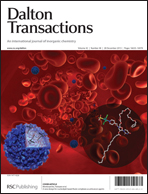Anti-leishmanial activity of heteroleptic organometallic Sb(v) compounds†
Abstract
In seeking new drugs for the treatment of the parasitic disease Leishmaniasis, an extensive range of organometallic antimony(V) dicarboxylates of the form [SbR3(O2CR′)2] have been synthesised, characterised and evaluated. The organometallic moieties (R) in the complexes vary in being Ph, tolyl (o, m or p), or benzyl. The carboxylates are predominantly substituted benzoates with some compounds incorporating acetato or cinnamato ligands. The crystal structures of [Sb(p-Tol)3(O2CC6H2-3,4,5-(OMe)3)2]·0.5PhMe and [SbPh3(m-CH3C6H4CH2CO2)2] were determined and shown to adopt a typical trigonal pyramidal geometry, being monomeric with a five coordinate Sb centre. In total, the biological activity of 26 Sb(V) compounds was assessed against the Leishmania major parasite, and also human fibroblast skin cells to give a measure of general toxicity. Of these, 11 compounds (predominantly substituted benzoates with m- or p-tolyl ligands) proved to be highly effective against the parasite amastigotes at concentrations of 0.5–3.5 μM, while being non-toxic towards the mammalian cells at levels below 25 μM, making them highly promising drug candidates.


 Please wait while we load your content...
Please wait while we load your content...